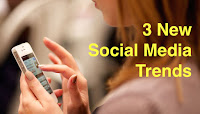 Social media is the lifeblood of so many artists, bands, musicians and record labels in terms of engaging and growing their fanbases. That means it's important to stay current on the latest developments so you don't get left behind.
Social media is the lifeblood of so many artists, bands, musicians and record labels in terms of engaging and growing their fanbases. That means it's important to stay current on the latest developments so you don't get left behind.With that in mind, there are 3 new trends in social media that are really heating up that you should keep an eye on, according to Kevan Lee of of the social posting tool Buffer in a post on thenextweb. Look out for the following:
1. Purchasing items directly from your News Feed.
We're already seeing this on Twitter, Instagram and Pinterest where your fan can make a purchase from within the app, which means she's avoided linking to the multiple steps in an external shopping cart and possibly losing the sale. Facebook has also been testing a Buy button for more than a year, and is slowly rolling it out to a specific group of advertisers.
One of the downsides of News Feed purchasing in the current crop of social platforms is that you usually need to be involved with a third part app like Shopify, Stripe or Gumroad to use as a payment processor/gateway, but if you're selling merch online already, chances are that you're already connected.
2. Custom social networks at work.
Companies are beginning to see the advantage of having their own internal social networks. The thought being that if employees are going to be on social media during the workday anyway, the company might as well have some control over it. Facebook at Work is the first network to jump into this game with a customized work version, but expect others to follow.
There are still a lot of unknowns here, but the trend is worth watching since it could affect the timing of your posts. In other words, it might be better to wait until after 5PM when people are away from their work networks so you can catch them on their personal networks. On the other hand, a work network might be able to be penetrated by a certain type of post, which then gives you the inside track at engagement. We'll know more as it rolls out.
3. How to reach people who aren't checking their feeds.
Social media is more broadcast while messaging is more personal. Many people prefer messaging because there are no algorithms involved, nor are there ads. As messaging becomes more popular, the influence of social lessens, as does your ability to reach your fans who depend less on a social platform. But what would happen if you could broadcast to a group of fans over a messaging app? Whatsapp has already started something like this with a newsletter that is broadcast to a wide group of people, and Everlane for Facebook allows a broadcast over Messenger.
The upside of this is that it gives your fans another way to hear from you if you give them multiple options when subscribing. The downside is that it can definitely clutter up a service with unwanted messages.
Many of the social distribution companies are also trying to wrap their heads around this one, but the hope is (at least from me) that messaging stays private. Don't be surprised if ads start to pop up in places that you never expected though.
(Photo: Sebastiaan ter Burg via Flickr)





